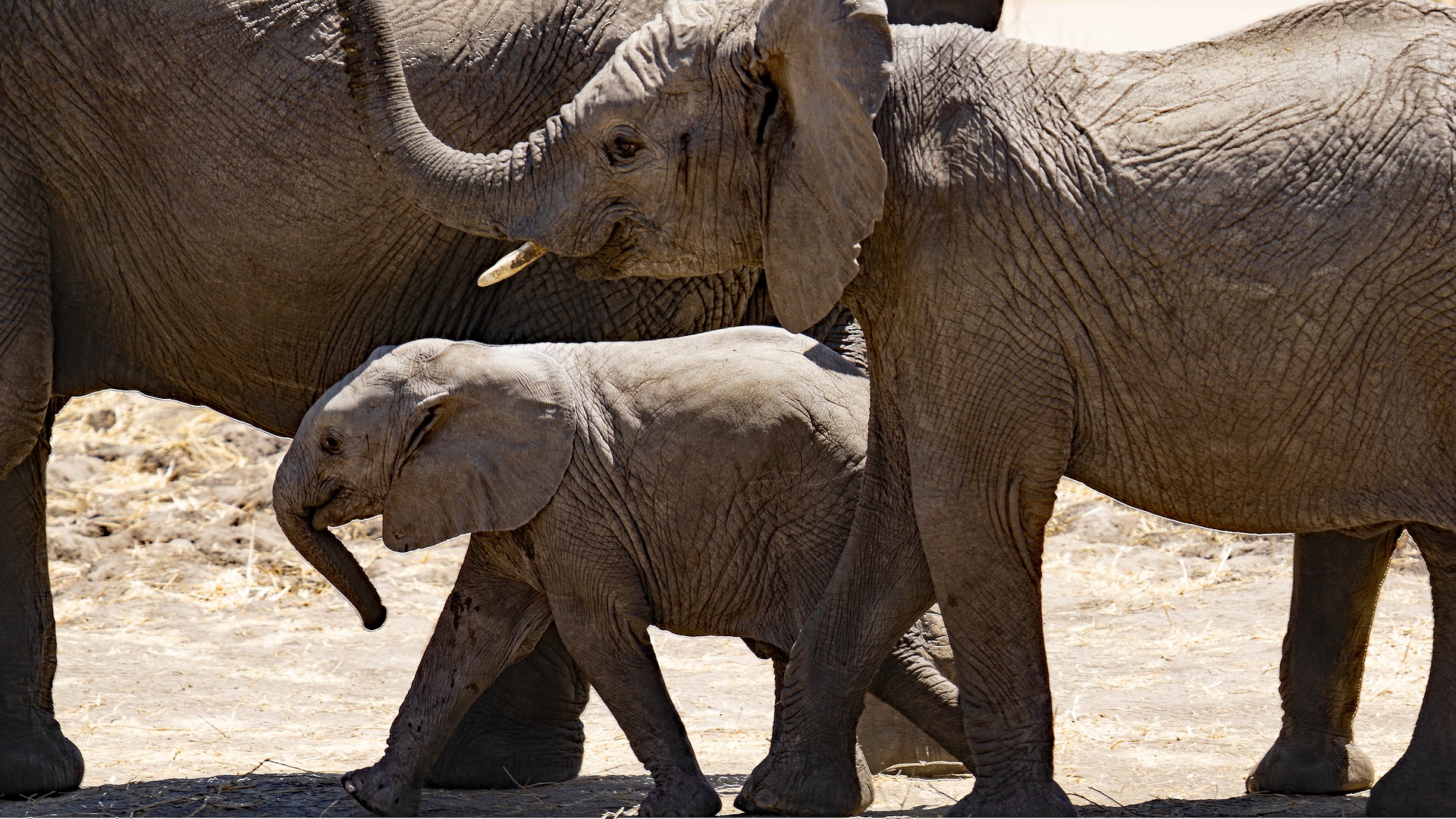Lesson Focus: Vocabulary
To get the most from this lesson:
(1) Look closely at the picture of the elephants.
(2) Read the text, deducing the meaning of the bold words.
(3) Complete the practice activities.
(4) Practice describing a similar animal.
He’s a calf. He’s the perfect meal for a pride of lions or a pack of wild dogs. Actually, he’s a week’s worth of meals! That’s why he’s staying very close to his herd, in-between an adult and an adolescent. Why is a calf big enough to be a week’s worth of meals for a number of animals? He’s an African elephant baby, and African elephants are the largest beings that walk the land.
Elephants are huge. And their overall giganticness isn’t the only thing that makes them unique, they also have a number of characteristic body parts that are unlike other animals.
The most unique characteristic of elephants is definitely their long trunks. The word trunk is used for a large variety of things in English, but this use probably comes from the nose’s similarity in appearance to a tree trunk. Elephant trunks are ginormous, averaging six feet long in adults, weighing about 400 pounds. Just its trunk alone is nearly double the weight of a grown man. It’s almost completely made of muscle, containing over 40,000 individual muscles, which makes it useful for eating, drinking, grabbing, moving, throwing, communicating, and even self-defense. Right now, though, this calf’s trunk has a lot of growing to do to become as powerful as his daddy’s.
Another identifying characteristic of elephants is their tusks. Tusks are a special kind of tooth that are always growing, eventually sticking out of the mouth of their owners if they live long enough. These, too, are humungous on elephants. There aren’t many animals with tusks, and so elephant tusks are in a class of their own for size. Walrus tusks weigh around 12 pounds, hippo tusks weigh around 5 pounds, the undersized warthog tusks weigh nearly half a pound, muntjac deer tusks are so small they can’t even be considered miniature, strap-toothed whale tusks are similar to walrus tusks, and narwhal tusks reach 22 pounds (and they only have one each). None come close to the whopping 100 pound elephant tusks, which they have two of for a total of 200 pounds of tusk! That’s 8 times more tusk than any other animal on the planet! Since these are used as weapons, elephants are literally armed to the teeth for self-defense. As calves, elephant tusks don’t stick out of the mouth, so this little one has to wait until he gets bigger to show off supersized teeth and needs to stay near the herd for protection.
We all know Dumbo the Elephant for his ability to fly around with his big, flappy ears. This story came about because elephants simply have the largest ears one could possibly want. They have easily the largest ears in the animal kingdom. They are so massive, that elephants use them to cool off their oversized bodies in the heat of the day as radiators, intimidate other animals by opening up and making the elephant appear more colossal than he is, and communicate to other elephants through flapping and moving. Of course, hearing what’s going on around them is enhanced with these monster sound cups.
We’ve saved the best for last: the skin. At a glance, elephant skin doesn’t seem all that fancy. In fact, it looks a bit like the forehead of your confused great-grandpa, but all over their bodies. Don’t think elephant skin is that simple! There are some amazing things going on in this unique characteristic of elephants that mankind only recently discovered. Think about it. How could a dark skinned animal be able to stay cool in the African sun without standing under a tree all day? There has to be something special about their skin. Elephant skin is thick and wrinkled, and when observed under a microscope, we find millions and millions of smaller wrinkles covering these giants from head to foot. These wrinkles are able to hold water and mud for long periods of time. What elephants do is roll around in the mud and throw dirt on themselves with their trunks. The water is trapped in the tiny wrinkles and the mud forms a protective layer on the outside. This keeps them protected from the sun like a sunscreen and helps them cool off as the water slowly evaporates, kind of like wearing a wet towel for us. On top of that, it aids to protect them from the swarms of bugs in Africa that like to live on the animals’ skin. If they didn’t have all of these large and microscopic wrinkles, the water would run off and the mud wouldn’t stick, and elephants would get cooked in the sun. Oh yeah, and an adult male elephant has around 2000 pounds skin, which is heavier than a mini car. This calf’s skin isn’t fully developed yet, so he has to spend extra time in the water and in the shade of his towering family members.
There is so much more to say about these mammoth creatures that sets them apart from others and makes us go “wow!” But for this little calf, all these things are normal and part of daily life. It makes you wonder what goes through his mind when he sees us miniscule, funny-looking, two-legged, smooth-skinned creatures watching him with mouth open wide.

